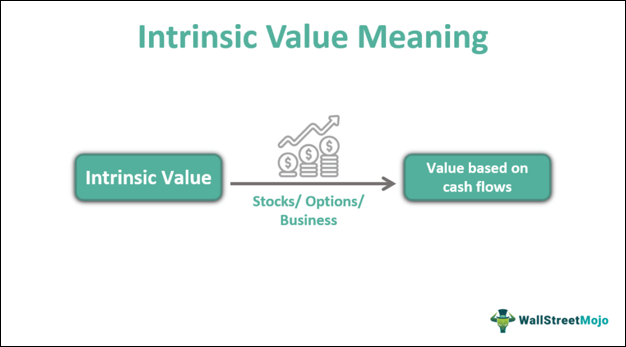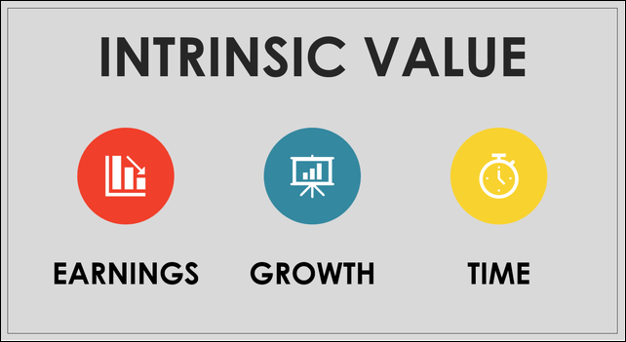In finance and investing, the term “intrinsic value” is often used to describe the true worth of a financial asset. So, what is intrinsic value? Intrinsic value is a concept that helps investors resolve whether an asset is overvalued or undervalued and can be calculated based on the asset’s underlying characteristics, such as its cash flows, earnings potential, and assets. This article will provide a detailed definition of intrinsic value, discuss standard methods used to calculate it and provide intrinsic value examples in investing.
Table of Contents
Intrinsic value in finance and investing refers to the actual worth of a financial asset based on its underlying characteristics, such as cash flows and earning potential. It is the value that an asset would have if all of its future cash flows were discounted back to its present value.
Investors use intrinsic value to determine whether a financial asset, such as a stock, bond, or real estate, is overvalued or undervalued. The concept of intrinsic value is subjective and can vary depending on the methodology and assumptions used to calculate it. Some standard intrinsic value calculation methods include discounted cash flow analysis, price-to-earnings ratios, and dividend discount models.

Intrinsic value is essential in finance and investing because it helps investors determine whether a financial asset is overvalued or undervalued. By calculating the intrinsic value of an asset, investors can determine potential buying or selling opportunities based on whether the market price is higher or lower than the asset’s intrinsic value.
If the intrinsic value surpasses the current market price, the asset may be considered undervalued and present a potential buying opportunity. Conversely, if the intrinsic value is lower than the market price, the asset may be considered overvalued and present a potential selling opportunity.
Using intrinsic value to make informed investment decisions can help investors avoid overpaying for assets and potentially earn higher returns by purchasing undervalued assets. Intrinsic value can also help investors evaluate the long-term potential of an asset, as it is based on the underlying characteristics of the asset rather than short-term market fluctuations.
So, how to calculate intrinsic value? There are several methods for it, each with its approach and assumptions. Here are five commonly used methods:
The Discounted Cash Flow (DCF) model is the first method in our list of answers to ‘how to calculate intrinsic value?’. It estimates a company’s intrinsic value by casting its future cash flows and discounting them to their present value. This model considers the time value of money and assumes that the value of a company is based on its ability to generate cash flows over time.
To use the DCF model, an analyst must first evaluate the future cash flows of the company, which can be done using a variety of approaches. The analyst must then select an appropriate discount rate to account for the time value of money and the risk associated with the investment. Finally, the analyst must calculate the present value of the cash flows to arrive at the company’s intrinsic value.
Next up, we have the Residual Income Model. It estimates a company’s intrinsic value by calculating its future residual income after deducting the cost of capital from its net income. The model assumes that the value of a company is based on its capacity to generate income over its cost of capital.
To use the residual income model, an analyst must first estimate the future net income of the company and the cost of capital. The analyst must then calculate the future residual income of the company by subtracting the cost of capital from the net income. Finally, the analyst must calculate the present value of the future residual income to arrive at the company’s intrinsic value. The residual income model is commonly used to evaluate financial institutions and companies with a good number of intangible assets.
The Dividend Discount Model is a method of estimating a company’s intrinsic value by discounting the future dividends that it is expected to pay to its shareholders. The model assumes that the value of a company is based on the current value of its future dividend payments.
An analyst must first estimate the company’s future dividend payments to use the dividend discount model. The analyst must then select an appropriate discount rate to account for the time value of money and the risk associated with the investment. Finally, the analyst must calculate the present value of the future dividend payments to arrive at the company’s intrinsic value. The dividend discount model is commonly used to evaluate stable, mature companies with a history of paying dividends.
Asset-based valuation is for estimating a company’s intrinsic value by considering the value of its assets minus its liabilities. This method assumes that the value of a company is based on the value of its tangible and intangible assets.
To use the asset-based valuation method, an analyst must first determine the fair market value of the company’s assets and liabilities. The analyst must then subtract the total liabilities from the assets to determine the company’s net asset value. Finally, the analyst must divide the net asset value by the number of outstanding shares of the company to arrive at the intrinsic value per share. The asset-based valuation method is commonly used to evaluate companies with significant tangible assets, such as real estate or manufacturing companies.
Analysis based on a financial metric is a method of calculating the intrinsic value of a company by considering a specific financial metric, like the price-to-earnings ratio (P/E), the price-to-book ratio (P/B), or the price-to-sales ratio (P/S). This method assumes that the value of a company is based on its capacity to generate earnings, book value, or revenue.
To use this method, an analyst must first select a financial metric relevant to the company’s industry and stage of development. The analyst must then compare the company’s financial metric to its peers to determine whether it is undervalued or overvalued. The analysis can also include other factors, such as the company’s growth prospects, management quality, and industry trends. This method is commonly used in the valuation of publicly traded companies.
We do hope we have answered the question ‘how to calculate intrinsic value?’ satisfactorily for you!

Some of the intrinsic value examples are as follows:
The first intrinsic value example is owner earnings. This refers to the cash a company makes available to the owners after deducting all necessary expenses. It can be calculated by taking net income and adding depreciation, amortization, and other non-cash expenses.
The second intrinsic value example we will talk about is the growth rate. This refers to the expected rate at which a company’s earnings will grow. It is usually based on the company’s historical growth rate, industry trends, and other relevant factors.
The third intrinsic value example will be the discount rate. This refers to the rate reached from discounting future cash flows to their present value. It is typically based on the risk associated with the investment and the expected return on other similar investments.
The fourth intrinsic value example is terminal value. This refers to the estimated value of a company at the end of a specific period.
Last but not least, an intrinsic value example is putting it all together. To calculate a company’s intrinsic value, we estimate its future owner earnings, determine a reasonable growth rate, apply a discount rate, and calculate the terminal value. We then add the present value of each component to arrive at the company’s intrinsic value. This analysis helps investors determine whether a company’s current stock price is overvalued or undervalued.
The pros and cons of intrinsic value are as follows:
| Pros of Intrinsic Value | Cons of Intrinsic Value |
|---|---|
| It provides a complete view of a company’s worth than its current stock price. | The intrinsic value calculation is based on assumptions and estimates, which can be subjective and may not always be accurate. |
| Encourages a long-term investment perspective by focusing on the company’s fundamental value. | Intrinsic value can be affected by external factors beyond a company’s control, such as market or economic changes. |
| It helps investors make more informed investment decisions based on a company’s financial performance and future growth potential. | The calculation of intrinsic value can be time-consuming and require a lot of research and analysis. |
| It can provide a margin of safety for investors by identifying undervalued stocks. | A company’s intrinsic value may not necessarily reflect its current market price, which can lead to confusion resulting from the discrepancies. |
And there you have it, your answer to the question ‘what is intrinsic value?’! Intrinsic value is a concept that helps investors determine the true worth of a company by looking at its fundamentals, future growth potential, and other relevant factors. The advantages of intrinsic value include providing a more comprehensive view of a company’s value and encouraging a long-term investment perspective.
It also has limitations, such as the subjectivity of its calculation and the influence of external factors. Investors should use intrinsic value to make informed investment decisions but also conduct additional research and analysis.
Intrinsic value is helpful because it gives investors a comprehensive view of a company’s worth beyond its current stock price. It considers the company’s financial performance, future growth potential, and other relevant factors to estimate its actual value accurately. This information can help investors make informed investment decisions and identify undervalued or overvalued stocks.
In options trading, the intrinsic value is also utilized to determine how much an option contract is worth. The distinction between the underlying asset’s market price and the option’s strike price is the option’s intrinsic value. The option has inherent value if it is “in the money,” which means the strike price is less than the underlying asset’s current market price. This information may assist traders in deciding whether an option is a viable investment and help them make better trading choices.
Layer 1 Blockchain | What is Blockchain | Web3 Programming Languages | Difference Between Cryptocurrency and Blockchain | Best Crypto Exchanges | Top Ethereum Bridges | Best NFT Discord Servers | What is Asset Tokenization | Ordinals NFTs | Best Crypto Faucets | Ethereum Account Abstraction | Blockchain Beyond Crypto | Peer to Peer Transactions Blockchain | Types of Cryptopunks | Difference Between Proof of Work and Proof of Stake | EVM Wallet Benefits | Custodial Wallets Vs Non Custodial Wallets | What is Consortium Blockchain | Decentralized Identifiers | What is a Blockchain Platform | Popular Metaverse Platforms | What is a Flash Loan Attack | Quantum Vs Blockchain | What is Decentralized Application | Benefits of Blockchain